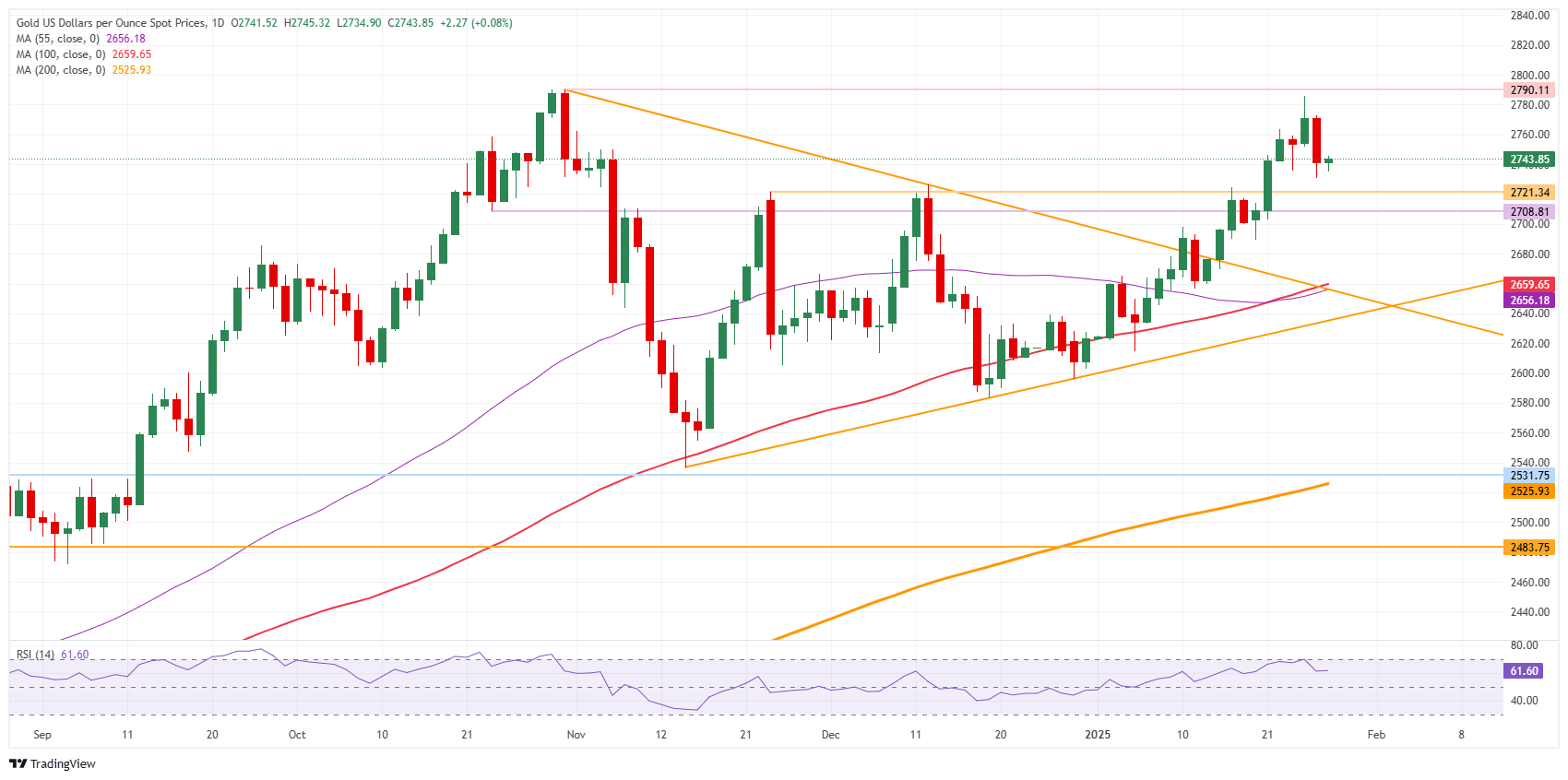- Gold stays muted on Tuesday ahead of the start of the US trading session after Monday’s market rout.
- President Trump to call for a higher than 2.5% global tariff implementation.
- Bullion bulls see the window of opportunity for a new all-time high in Gold decreases.
Gold’s price (XAU/USD) sees traders throwing around the ball and not making any bets this Tuesday, following an over 1% dive the previous day after the Chinese AI startup DeepSeek shook up markets. The result is not tiny, with over $550 billion in market capitalization going up in smoke for Nvidia alone. Seeing the tech-sensitivity, cryptocurrencies such as Bitcoin also took it on the chin, with Bitcoin (BTC) losing over 6.5% at one point among one of the spillover victims in the financial markets asset classes.
This plays into the hands of United States (US) President Donald Trump, who again demanded global tariffs. The belief is that doing so will better defend US tech companies and shield them from China’s dumping strategy. The rule of thumb remains that tariffs are inflationary, which means higher yields, which is a headwind for Bullion.
Later this week, the Federal Reserve (Fed) and the European Central Bank (ECB) will decide on policy interest rates on Wednesday and Thursday, respectively.
Daily digest market movers: Tariffs confirmed by Trump and Bessent
- Asian markets will quiet down this week and next week. With the Lunar New Year starting this Tuesday, Chinese traders will return to the markets on February 5.
- The Financial Times reported that Treasury Secretary Scott Bessent is pushing for universal tariffs on US imports to start at 2.5% and rise gradually, citing unnamed sources. President Trump subsequently said that he wants across-the-board levies that are “much bigger” than that, Bloomberg reported.
- The CME FedWatch tool projects no change in the policy rate for Wednesday's Federal Reserve interest rate decision. Going forward, the probability of a 25 basis point rate cut in the May rate decision is 40.0%, compared to 51.5% for no change.
- Barrick Gold (ABX CN) and Mali will begin new negotiations on Tuesday. Barrick Gold and Mali will attempt to resolve a dispute over the alleged non-payment of taxes and the seizure of Barrick’s gold stocks by authorities in the country, Reuters reports.
Technical Analysis: Inflation concerns back on top
Gold’s price rally takes a step back and might need to look for further support on the downside. Markets were blindsided by President Trump, who had already come in quite hard over the weekend with tariff threats for Colombia and now puts universal tariffs back on the table. Inflationary concerns triggered by these tariffs could mean higher yields, possibly no rate cuts in 2025 and thus headwinds for Gold.
The first line of support remains at $2,721, a sort of double top in November and December broken on January 21. Just below that, $2,709 (October 23, 2024, low) is in focus as a second nearby support. In case both abovementioned levels snap, look for a dive back to $2,680 with a full-swing sell-off.
Although the window of opportunity is starting to close, Gold could still hit the all-time high of $2,790, which is around 2% away from current levels. Once above that, a fresh all-time high will present itself. Meanwhile, some analysts and strategists have penciled in calls for $3,000, but $2,800 looks to be a good starting point as the next resistance on the upside.
XAU/USD: Daily Chart
Tariffs FAQs
Tariffs are customs duties levied on certain merchandise imports or a category of products. Tariffs are designed to help local producers and manufacturers be more competitive in the market by providing a price advantage over similar goods that can be imported. Tariffs are widely used as tools of protectionism, along with trade barriers and import quotas.
Although tariffs and taxes both generate government revenue to fund public goods and services, they have several distinctions. Tariffs are prepaid at the port of entry, while taxes are paid at the time of purchase. Taxes are imposed on individual taxpayers and businesses, while tariffs are paid by importers.
There are two schools of thought among economists regarding the usage of tariffs. While some argue that tariffs are necessary to protect domestic industries and address trade imbalances, others see them as a harmful tool that could potentially drive prices higher over the long term and lead to a damaging trade war by encouraging tit-for-tat tariffs.
During the run-up to the presidential election in November 2024, Donald Trump made it clear that he intends to use tariffs to support the US economy and American producers. In 2024, Mexico, China and Canada accounted for 42% of total US imports. In this period, Mexico stood out as the top exporter with $466.6 billion, according to the US Census Bureau. Hence, Trump wants to focus on these three nations when imposing tariffs. He also plans to use the revenue generated through tariffs to lower personal income taxes.
Information on these pages contains forward-looking statements that involve risks and uncertainties. Markets and instruments profiled on this page are for informational purposes only and should not in any way come across as a recommendation to buy or sell in these assets. You should do your own thorough research before making any investment decisions. FXStreet does not in any way guarantee that this information is free from mistakes, errors, or material misstatements. It also does not guarantee that this information is of a timely nature. Investing in Open Markets involves a great deal of risk, including the loss of all or a portion of your investment, as well as emotional distress. All risks, losses and costs associated with investing, including total loss of principal, are your responsibility. The views and opinions expressed in this article are those of the authors and do not necessarily reflect the official policy or position of FXStreet nor its advertisers. The author will not be held responsible for information that is found at the end of links posted on this page.
If not otherwise explicitly mentioned in the body of the article, at the time of writing, the author has no position in any stock mentioned in this article and no business relationship with any company mentioned. The author has not received compensation for writing this article, other than from FXStreet.
FXStreet and the author do not provide personalized recommendations. The author makes no representations as to the accuracy, completeness, or suitability of this information. FXStreet and the author will not be liable for any errors, omissions or any losses, injuries or damages arising from this information and its display or use. Errors and omissions excepted.
The author and FXStreet are not registered investment advisors and nothing in this article is intended to be investment advice.
Recommended content
Editors’ Picks

AUD/USD holds steady above 0.6300; looks to US NFP for fresh impetus
AUD/USD stalls the previous day's pullback from the 0.6400 neighborhood, or over a two-week high, and oscillates in a range during the Asian session on Friday ahead of the US NFP. In the meantime, the USD struggles to lure buyers as Trump's sweeping tariffs lift recession fears, which might force the Fed to resume its rate-cutting cycle soon.

USD/JPY recovers slightly from multi-month low; upside seems limited ahead of US NFP
USD/JPY attracts some buyers during the Asian session on Friday and moves away from its lowest level since October set the previous day. Investors scale back their expectations that the BoJ would raise policy rate at a faster pace amid worries that Trump's new tariffs could negatively impact Japan's economy, which is seen weighing on the JPY.

Gold holds positive ground above $3,100, all eyes on US NFP data
Gold price recovers some lost ground to near $3,115 during the late American session on Thursday after facing some profit-taking in the previous session. Escalating concerns over a global trade war and ongoing geopolitical risks boost the Gold price, a traditional safe-haven asset.

Ethereum: Short-term holders may not impact ETH's price, Pectra mainnet upgrade set for May 7
Ethereum declined by 3% on Thursday as market participants continued to react to President Donald Trump's announcements regarding reciprocal tariffs. However, the selling pressure may not persist since most ETH short-term holders already sold their assets in March.

Trump’s “Liberation Day” tariffs on the way
United States (US) President Donald Trump’s self-styled “Liberation Day” has finally arrived. After four straight failures to kick off Donald Trump’s “day one” tariffs that were supposed to be implemented when President Trump assumed office 72 days ago, Trump’s team is slated to finally unveil a sweeping, lopsided package of “reciprocal” tariffs.

The Best brokers to trade EUR/USD
SPONSORED Discover the top brokers for trading EUR/USD in 2025. Our list features brokers with competitive spreads, fast execution, and powerful platforms. Whether you're a beginner or an expert, find the right partner to navigate the dynamic Forex market.




